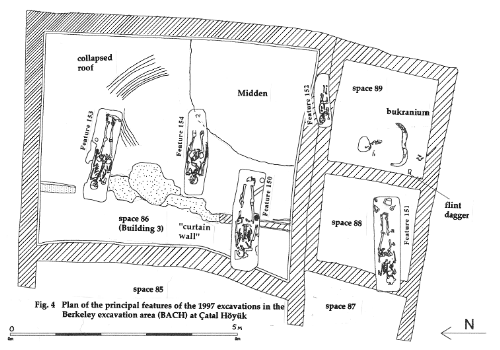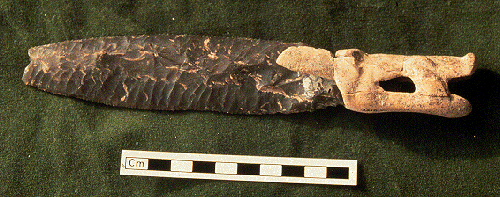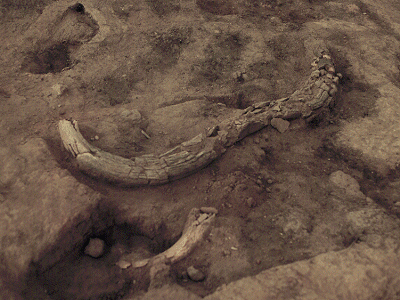BACH AREA
by Ruth Tringham

(left) Figure 13: Bach Area with excavated features
An 11 x 7 m area (fig 13) was selected for excavation by the Berkeley project immediately to the east of the "North" area for various intellectual and practical reasons (see fig 3). We wanted to link the excavated architecture in the Bach area with North to be able to consider the question of life-histories of houses in a "neighborhood", the question of continuity and social formation of the East Mound (and "tells" in general). Spaces 85, 86 and 89 had been very productive of architecture and artifacts in the surface scrape of 1984. This was an important consideration in constructing what would be a permanent fixture (i.e. the shelter)over the excavated area. The shelter also required a relatively flat area for its foundations.
During our 1997 season we focused on two of these spaces: the large room (space 86) and the small room with a bucranium on its surface (space 89). Initially we excavated 5 late Roman/early Byzantine burials cut into the fills of these spaces. It is not surprising that we have found graves of this period on top of the East Mound, considering that there was a large settlement of the period not far away, and the significance we can imagine the mound had as part of the cultural landscape of the occupants of that settlement. It seems an interesting direction for research to use the positioning of the graves as a means to understanding how much was known about the Neolithic architecture and how much was visible and in what way meaningful to the diggers of the Roman/Byzantine graves. In order for this report to be available on time, we have to defer this topic to a later time.
We have started excavating a large and elaborate building (Building 3). This has thickly plastered walls with red and black paint in the main room (Space 86) and a large set of complete bulls horns and a flint dagger in a small side room (Space 89). In the main room floors were not reached but a bull's horn was found against the east wall. The fill of this room contained midden material. It also contained evidence of sloping layers of plaster and midden which may be a collapsed roof. Excavation of this in 1998 will allow us to examine Mellaart's hypothesis that the roofs were flat and that they had entranceways. Perhaps most important, it will allow us to examine the range of activities that took place on the roof. A collapsed screen occurred along the western side of the room.

Figure 14: Dagger found in Bach area during 1997 excavations
|
Figure 15: Bach Area: Large Bucranium |
While excavating southwest of the large bucranium (fig 15), another horn core fragment was found, and next to this was found (by Mirjana Stevanovic) a spectacular find of flint pressure-flaked dagger in a carved bone handle (fig. 14). The latter has already been reconstructed and appears to be carved in the shape of an animal (wild boar's?) head. It is very similar to one found by James Mellaart, now displayed in the Anatolian Museum in Ankara. That one, however, was from a burial, whereas this one does not seem to be in such a context (although fragments of human bone had been found nearby). |
